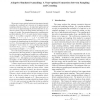Free Online Productivity Tools
i2Speak
i2Symbol
i2OCR
iTex2Img
iWeb2Print
iWeb2Shot
i2Type
iPdf2Split
iPdf2Merge
i2Bopomofo
i2Arabic
i2Style
i2Image
i2PDF
iLatex2Rtf
Sci2ools
FOCS
2007
IEEE
2007
IEEE
Adaptive Simulated Annealing: A Near-optimal Connection between Sampling and Counting
We present a near-optimal reduction from approximately counting the cardinality of a discrete set to approximately sampling elements of the set. An important application of our work is to approximating the partition function Z of a discrete system, such as the Ising model, matchings or colorings of a graph. The standard approach to estimating the partition function Z(β∗ ) at some desired inverse temperature β∗ is to define a sequence, which we call a cooling schedule, β0 = 0 < β1 < · · · < β = β∗ where Z(0) is trivial to compute and the ratios Z(βi+1)/Z(βi) are easy to estimate by sampling from the distribution corresponding to Z(βi). Previous approaches required a cooling schedule of length O∗ (ln A) where A = Z(0), thereby ensuring that each ratio Z(βi+1)/Z(βi) is bounded. We present a cooling schedule of length = O∗ ( √ ln A). For well-studied problems such as estimating the partition function of the Ising model, or approximating the number of co...
| Added | 02 Jun 2010 |
| Updated | 02 Jun 2010 |
| Type | Conference |
| Year | 2007 |
| Where | FOCS |
| Authors | Daniel Stefankovic, Santosh Vempala, Eric Vigoda |
Comments (0)

